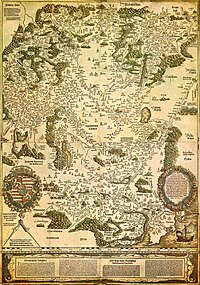
Photo from wikipedia
The Carpathian Mountains provide critical wildlife habitat in central Europe, and previous genome-wide studies have found western Carpathian Mountain wolves ( Canis lupus ) to be a separate population. Whereas… Click to show full abstract
The Carpathian Mountains provide critical wildlife habitat in central Europe, and previous genome-wide studies have found western Carpathian Mountain wolves ( Canis lupus ) to be a separate population. Whereas differentiation to the north may be explained by a lowland-mountain transition and habitat fragmentation, the eastern Carpathian Mountains extending through Romania appear to offer continuous wildlife habitat southward. Our objective was to assess gene flow patterns and population connectivity among wolves in Romania, western Ukraine, and the Republic of Moldova. We sought to determine if the Carpathian Mountain region is best described by a north–south gradient in genetic profiles, or whether Romanian wolves show population structure with northern individuals clustering with western Ukraine. We genotyped 48 individuals with 170 000 single nucleotide polymorphism markers, and successful profiles from Romania (n = 27) and Moldova (n = 2) were merged with existing data from western Ukraine (n = 10). Expected heterozygosity was 0.234 (SE 0.001) for Romania and 0.229 (SE 0.001) for western Ukraine, whereas observed heterozygosity values were 0.230 (SE 0.001) versus 0.231 (SE 0.001). Population structure analyses with a maximum likelihood method supported K = 1 population, followed by K = 2 where Romania formed one cluster, and western Ukraine and Moldova formed another. Principal component analysis results were broadly consistent with K = 2. Pairwise F ST between western Ukraine and Romania was 0.042 (p = 0.001). Our findings indicated weak population differentiation, and future research may clarify whether the spatial distribution of genetic diversity in the region is associated with environmental and ecological factors such as terrain ruggedness and the distribution of prey species.
Journal Title: Genetica
Year Published: 2019
Link to full text (if available)
Share on Social Media: Sign Up to like & get
recommendations!